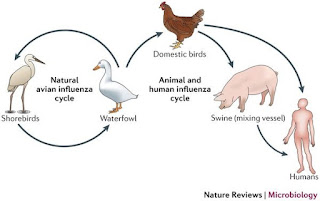In 2009 my husband Will and I spent a month in Italy. I hadn't been to Europe in fourteen years
and was eager to return to its history and culture, but a little anxious about the adventure. Shortly before we were due to leave, the swine flu hit Mexico and the United States. Unlike most flus, including the current Coronavirus (COVID-19), the swine flu (H1N1) didn't largely kill the elderly and sick. A strain of the 1918 Spanish influenza virus, many healthy, younger people succumbed to H1N1, which quickly spread to Europe. People talked of a worldwide pandemic. And here we were setting out on a plane into this risky situation. I thought of cancelling the trip. But, out of my anxiety came an idea for a short story. A man, grieving the death of his wife, travels through Italy, worried about catching the swine flu. I'd call the story "Pandemic."
 |
| 2009 H1N1 (Swine flu) Pandemic - laboratory confirmed cases and deaths |
In the Rome airport, I noticed several people wearing surgical masks. This struck me as unusual, but now would be common for travel at any time. When I later wrote the story, I included this detail along with others I wrote in a journal I carried through Rome, Venice, Tuscany and Sorrento. Will and I rented weekly apartments in these locations, as did Tony, my story protagonist. I took photos and made notes about our residences, which were part of the story landscape along with the tourist attractions that Tony, Will and I visited.. "Pandemic's" first turning point occurs when Tony is impressed by Bernini's sculptures in the Galleria Borghese Museum in Rome. Tony thinks, as I did, that he is witnessing genius. How
did Bernini make a pinch of skin on a marble
thigh look soft and real?
Aside from occasional sightings of surgical masks, I forgot about the swine flu while absorbing Italy's museums, eating pizza and drinking wine in cafes, exploring ancient sites and warrens of medieval streets. After our trip, The World Health Organization declared H1N1/09 a Pandemic. It was tragic for the people who died. They were far fewer in number than those who die annually from a seasonal flu, and this is expected to be the case with COVID-19.
At home, I returned to my novel-in-progress, but Tony's story kept churning through my mind. Eventually, I sat down and wrote "Pandemic," my first work of fiction set in another country. Aided by my photos and journal notes, I found setting descriptions easier to write than ones in my stories set in Canada. Tony's encounter with two sisters while climbing the Leaning Tower of Pisa felt fresher than scenes of people meeting in ordinary, North American restaurants. I've sometimes thought of "Pandemic" as part story, part travelogue.
 |
| In "Pandemic," Tony and the sisters take comical photos of each other 'holding up' the Leaning Tower of Pisa |
"Pandemic" isn't published yet. At almost 12,000 words, it's too long for most short story markets and too short for a novella, much less a novel. I've broken "Pandemic" down into four standalone stories, set in the different Italian locations. The Venice standalone is titled "Gondolier Groupies;" Tuscany is "La Brezza." Still no luck with publication. Now, COVID-19 has prompted me to dust off "Pandemic" and revise the whole story again.
I find it interesting to work on a story that aligns with the zeitgeist. Today's constant news and worry about a pandemic infuses Tony's actions and the story descriptions. I'd have thought that immersing myself in the fictional world of a crisis similar to COVID-19 might make me anxious about our present situation. Instead, it's a release from concerns of impending disaster, and this is one reason writers write.
 |
| In Venice, Tony embarks on an ill-fated adventure with two young women and a pair of gondoliers |



































